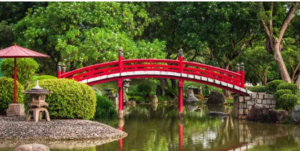In a world where haste seems to dictate our every move, finding solace in tranquillity becomes increasingly essential. Japanese garden design in Adelaide, with its meticulous attention to detail and reverence for nature, stands as an enduring symbol of serenity amidst life’s chaos. Rooted in centuries-old traditions and philosophical principles, these gardens offer more than just aesthetic pleasure—they provide a pathway to inner peace and spiritual harmony.
 Origins and Philosophical Underpinnings
Origins and Philosophical Underpinnings
Japanese garden design finds its roots in ancient Japan, dating back to the Asuka period (538-710 AD) when Buddhism was introduced to the country. Influenced by Chinese garden aesthetics and Zen Buddhist principles, Japanese gardens evolved to reflect a deep appreciation for the ephemeral beauty of nature and the impermanence of life.
Central to Japanese garden design is the concept of “wabi-sabi,” which celebrates the beauty of imperfection, impermanence, and simplicity. This philosophy emphasizes the acceptance of transience and the appreciation of the natural cycle of growth and decay. Every element in a Japanese garden, from the carefully placed stones to the meticulously pruned trees, embodies this principle, reminding visitors of the fleeting nature of existence.
Elements of Japanese Garden Design
Japanese gardens are meticulously crafted landscapes that incorporate various elements to evoke a sense of harmony, balance, and tranquillity. These elements are carefully arranged to create a seamless integration between the natural and the manufactured, inviting visitors to immerse themselves in a contemplative experience.
- Water Features: Water plays a central role in Japanese garden design, symbolizing purity, tranquillity, and the flow of life. Ponds, streams, and waterfalls are often incorporated into garden layouts, with carefully placed rocks and vegetation enhancing the natural beauty of these features.
- Rocks and Stones: Rocks are regarded as the “bones” of a Japanese garden design in Adelaide, representing stability and endurance amidst the changing seasons. These rocks are strategically placed to create focal points, pathways, and symbolic formations, such as islands or mountains, echoing the natural landscapes of Japan.
- Plants and Trees: The selection and arrangement of plants and trees are meticulously planned to reflect the changing seasons and create a sense of harmony with the surrounding environment.
- Bridges and Pathways: Bridges and pathways meander through Japanese gardens, guiding visitors on a journey of discovery and contemplation.
- Tea Houses and Pavilions: Tea houses and pavilions are integral elements of Japanese garden design, providing spaces for meditation, tea ceremonies, and quiet reflection. These structures are often nestled amidst lush foliage or overlooking scenic vistas, offering sanctuary from the outside world.
Types of Japanese Gardens
Japanese gardens come in various styles, each with its own distinctive characteristics and design principles. Some of the most notable types include:
- Karesansui (Dry Landscape) Gardens: Also known as Zen gardens, karesansui gardens feature minimalist compositions of rocks, gravel, and moss, meticulously raked to represent flowing water or ripples on a pond. These gardens are designed to evoke a sense of calmness and contemplation, encouraging visitors to find inner peace through quiet reflection.
- Tsukiyama (Hill and Pond) Gardens: Tsukiyama gardens recreate natural landscapes, incorporating hills, ponds, and forests to create a picturesque setting reminiscent of Japan’s countryside.
- Chaniwa (Tea Garden): Chaniwa gardens are designed specifically for the practice of tea ceremonies, with tea houses, stone paths, and water basins arranged in a manner that reflects the principles of wabi-sabi. Contemporary Interpretations and Global Influence
While rooted in centuries-old traditions, Japanese garden design in Adelaide continues to evolve and adapt to contemporary sensibilities. Today, designers around the world draw inspiration from Japanese aesthetics, incorporating elements of Japanese garden design into public parks, residential landscapes, and urban spaces.
In a fast-paced world fraught with distractions, Japanese gardens stand as sanctuaries of serenity, offering a glimpse into a timeless realm where beauty, simplicity, and harmony reign supreme. As we navigate the complexities of modern life, perhaps we can find solace and inspiration in the enduring legacy of Japanese garden design—a testament to the enduring power of nature to nourish the soul and awaken the spirit.
